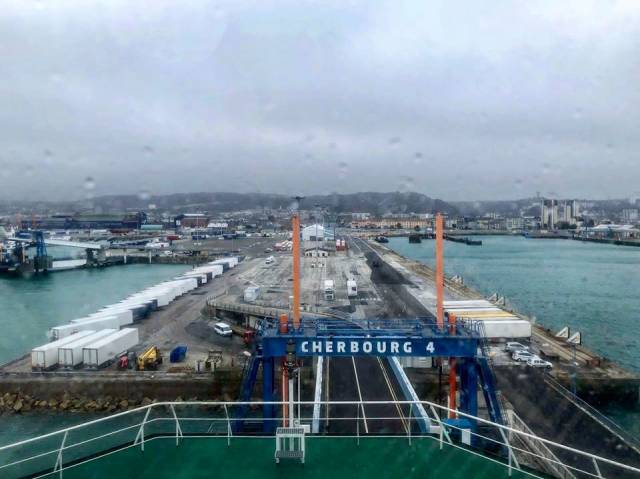#ferries - Its been a momentous week for W.B. Yeats as the new €144m cruiseferry won prestigious international shipping awards ahead of completing a first round trip voyage to France having arrived back in Dublin Port this morning, writes Jehan Ashmore.
The operator of the 1,800 passenger, 300 car and 165 truck capacity cruiseferry, Irish Ferries choose the return leg, Cherbourg to Dublin to be the 'official' maiden voyage so to enable marking the start of the St. Patrick's Day weekend in France. To celebrate the occasion, the port in Normandy was lit-up in the emerald green of Ireland, much to the delight of passengers and crew.
In fact the impressive 51,388 gross tonnage W.B. Yeats, the largest ever to serve on any Ireland-France route and the largest custom-built ferry for the operator, had actually carried out its inaugural commercial crossing on the route's outbound sailing. This involved a departure from Dublin on Thursday afternoon and with an arrival yesterday in the French port.
The WB Yeats though first began service for Irish Ferries on the Dublin-Holyhead route in mid-January, but now concentrates by operating between Dublin and Cherbourg. This will see a 20% greater passenger capacity and up to 4 days per week.
Passengers have the luxury of space, free WiFi, a choice of cinema screen movies and shopping, many bars and restaurants on-board in addition to outside decks to take in the views. A notable feature among the ship's green credentials is a 'scrubber' technology to meet the EU Sulphur Directive and so reduce harmful emissions into the environment.
The debut of W.B. Yeats is expected to provide a major boost to trade and tourism between France and Ireland, though it follows a much delayed entry into service due for last summer leading to cancellations. As widely reported last year, W.B. Yeats was beset with delays during construction at the German shipyard of Flensburger Schiffbau-Gesellschaft (FSG), Flensburg. This was due to third party contractors unable to meet FSG's timeframe in keeping to a schedule to deliver the ship on time on the Dublin-France route. See related compensation story, here.
It was at the French port yesterday where the importance of the route for both tourism and trade was highlighted by Herve Morin, President of Ports de Normandie who said, “With bilateral trade between France and Ireland accounting for almost €20 billion and with French people taking over 500,000 trips to Ireland annually, the Cherbourg to Dublin crossing plays an immensely important role in supporting tourism and trade links between both nations. Ports de Normandie is delighted to celebrate the maiden voyage of the W.B. Yeats from Cherbourg, knowing that it will further strengthen the long and enduring ties of friendship, family, and culture between France and Ireland.”
This afternoon W.B. Yeats is scheduled to depart Dublin on its second sailing outbound to mainland continental Europe, though Irish Ferries have still yet to confirm whether they are to resume seasonal services out of Rosslare Europort to France. As Afloat previously reported in December Irish Ferries announced that they are unlikely to operate a service between Rosslare and France in 2019 and the operator added they would continue to keep this situation under review.
The uncertainty over the Rosslare based routes to Cherbourg and Roscoff, Brittany, is set against the backdrop of the forthcoming Easter Bank Holiday. In addition the implications of tourism and trade in the south-east region given the potential impacts of whatever Brexit scenario arises.






























































